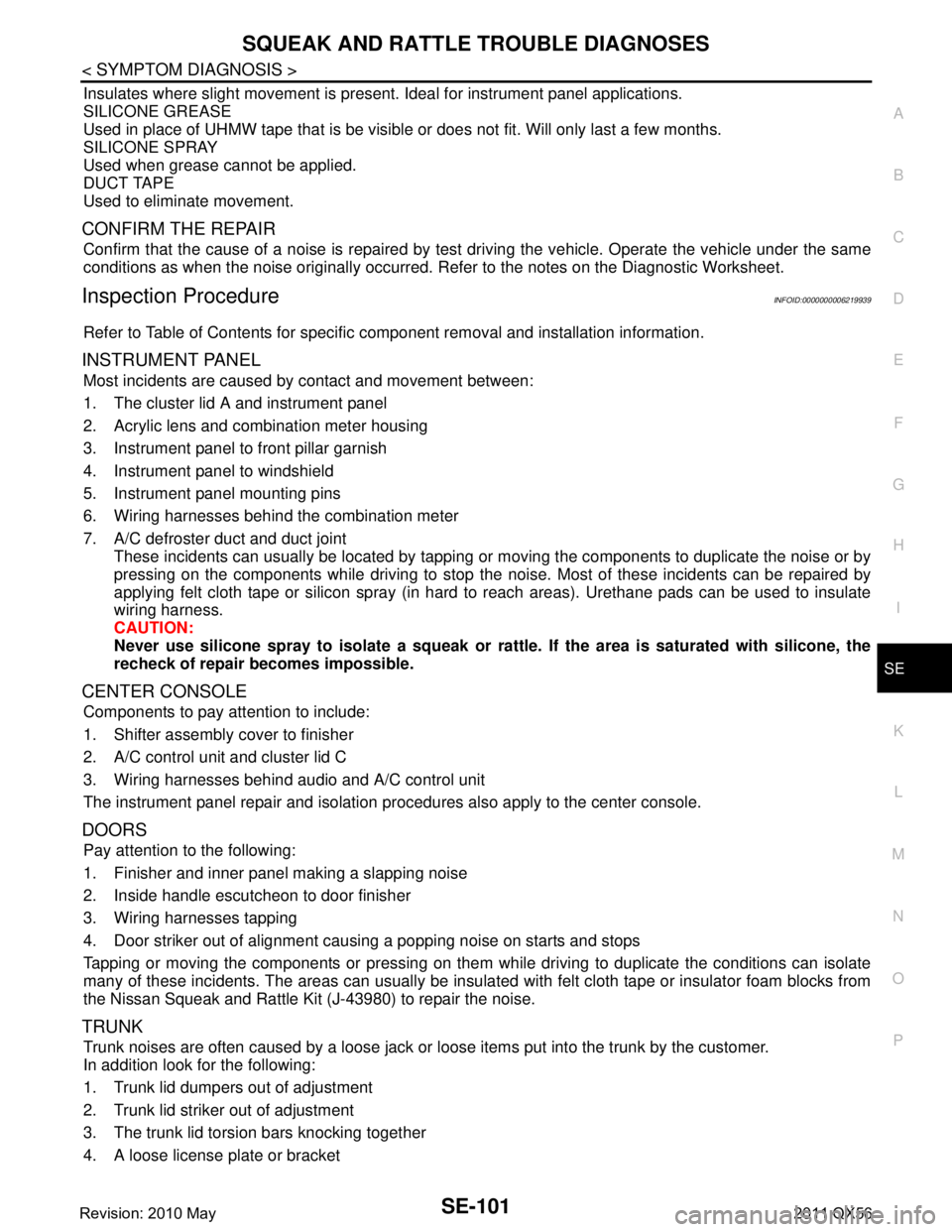2011 INFINITI QX56 stop start
[x] Cancel search: stop startPage 4477 of 5598

SE-18
< SYSTEM DESCRIPTION >
SYSTEM
Malfunction Malfunctioning condition
The temperature difference between the seatback ther-
mal electric unit and seat cushion thermal electric unit is
more than 30 °C When it detects for 4 seconds that the temperature difference between
the seatback thermal electric unit and seat cushion thermal electric unit
is more than 30 °, it stops the output to the thermal electric unit, activates
the climate controlled seat blower motor at the maximum position, and
sends the external airflow for 30 seconds
If the temperature difference is still more than 30 °C after 30 seconds
pass, it stops all output and enters the system OFF condition
When the temperature difference between seatback thermal electric unit and seat cushion thermal electric unit becomes less than 20 °C, the sys-
tem recovers automatically
If it detects that the temperature difference is more than 30 °C after the
automatic system recovery, it immediately stops all output and enters the
system OFF condition
NOTE:
When the switch operation is performed before entering the system OFF
condition, the fail-safe mode is reset.
The temperature of thermal electric unit is more than
11 0 °C in the HEAT mode (any thermal electric unit in the
seatback or seat cushion) When it detects for 4 seconds that the temperature of the thermal electric
unit is more than 110 °C, it stops the output to the thermal electric unit,
activates the climate controlled seat blower motor at the maximum posi-
tion, and sends the external airflow for 30 seconds
If the temperature does not become less than 105 °C after 30 seconds
pass, it stops all output and enters the system OFF condition
When the temperature of the thermal electric unit becomes less than 105 °C, the system recovers automatically
If it detects that the temperature of the thermal electric unit is more than
11 0 °C after the automatic system recovery, it immediately stops all out-
put and enters the system OFF condition
The temperature of the thermal electric unit is more than
45 °C in the COOL mode (any thermal electric unit in the
seatback or seat cushion) When it detects for 4 seconds that the temperature of the thermal electric
unit is more than 45 °C and less than 70 °C, it starts the temperature mon-
itoring of the thermal electric unit at 3 second intervals
While monitoring, if it detects that the temperature continuously rises 2 °C
or more 4 times or reaches 70 °C or more, it stops all output and enters
the system OFF condition
If it detects other results of monitoring, it continues activating in the COOL mode
Thermal electric unit sensor open circuit
(in either the back and the cushion TEU) When it detects for 4 seconds that the thermal electric unit sensor is an
open circuit, it stops all output and enters the system OFF condition
Climate controlled seat blower motor system open circuit
(in either the back and the cushion blower) When it detects for 2 seconds that climate controlled seat blower motor
is an open circuit while the climate controlled seat is being activated, and
the battery status has been stable for the same 2 second period. it stops
output to the thermal electric unit
When it detects for 10 seconds that the climate controlled seat blower motor is an open circuit while the climate controlled seat is being activat-
ed, and the battery status has been stable for the same 10second period.
it stops all output and enters the system OFF condition
NOTE:
After detecting the climate seat blower motor system open circuit for 2
seconds, the system recovers automatically if the activation of the cli-
mate controlled seat blower motor is detected for 1 second or more.
Switch input out of the specified range
(either heat input or cool input) When it detects for 4 seconds that the rotary switch input is less than
30% of the vehicle battery voltage, it stops all output and enters the sys-
tem OFF condition
When the switch input returns to a value within the specified range, the system recovers automatically
Revision: 2010 May2011 QX56
Page 4478 of 5598

SYSTEMSE-19
< SYSTEM DESCRIPTION >
C
DE
F
G H
I
K L
M A
B
SE
N
O P
*: System voltage is the voltage between the climate controlled seat control unit power source and ground.
NOTE:
When the ignition status changes to OFF during the fail-safe mode, the control unit shall enter the OFF condition. If the ignit ion is turned
ON, the system shall return to the standby mode. If the system en ters in the fail-safe mode again after performing ignition cycle, start the
diagnosis. HEAT or COOL switch input out of the specified range
During the standby mode, heating or cooling states, if the rotary switch
input is 6% or less of the vehicle battery voltage, it stops all output and
enters the system OFF condition
When the switch input returns to a value within the specified range, the system recovers automatically
System voltage out of range If the system voltage at the climate controlled seat control unit falls out-
side of the 8.5 to 16.5 V operating range, it stops all output after a 500ms
time period.
When the system voltage returns to the normal operating range (10.5-
15.5V with a 500ms hysteresis), the system recovers automatically.
Malfunction Malfunctioning condition
Revision: 2010 May2011 QX56
Page 4480 of 5598

CLIMATE CONTROLLED SEAT CONTROL UNITSE-21
< ECU DIAGNOSIS INFORMATION >
C
DE
F
G H
I
K L
M A
B
SE
N
O P*:It changes between 12 and 0 V
NOTE:
Measure the value on the condition that the battery voltage is 14 V
Wait 1 minute or more after thermal electric unit is activated, and then start the measurement
Fail-safeINFOID:0000000006217380
Climate controlled seat control unit equips fail-safe function.
When a malfunction occurs in the systems shown below , climate controlled seat control unit stops output.
63
(-) Ground Seatback blower motor
speed control signal Output Climate controlled seat switch HEAT 5.5 - 8
HI COOL 11.2
MID COOL 8
LO COOL 6.5
64 (-) Ground Blower motor ground — — 0
67 (-) Ground Seat cushion thermal electric
unit HEAT signal
Output Climate controlled seat switch HEAT or COOL 0 - 12*
OFF 0
68 (-) Ground Seat cushion thermal electric
unit COOL signal
Output Climate controlled seat switch HEAT or COOL 0 - 12*
OFF 0
69 (-) Ground Seat cushion thermal electric
unit sensor ground — Ignition switch ON 0
70 (-) Ground Seat cushion thermal electric
unit sensor signal
Input Climate controlled seat operated 1 - 5
71 (-) Ground Seat cushion blower motor
power supply OutputClimate controlled seat switch HEAT or COOL 12
Other than the above 0
72 (-) Ground seat cushion blower motor
speed control signal Output Climate controlled seat switch HEAT 5.5 - 8
HI COOL 9.2
MID COOL 8
LO COOL 6.5
74 (-) Ground Ignition switch power supply Input Ignition switch ON Battery voltage
Terminal No.
(Wire color) Description
ConditionVoltage (V)
(Approx.)
+ – Signal name Input/
Output
Revision: 2010 May2011 QX56
Page 4481 of 5598

SE-22
< ECU DIAGNOSIS INFORMATION >
CLIMATE CONTROLLED SEAT CONTROL UNIT
Malfunction Malfunctioning condition
The temperature difference between the seatback ther-
mal electric unit and seat cushion thermal electric unit is
more than 30 °C When it detects for 4 seconds that the temperature difference between
the seatback thermal electric unit and seat cushion thermal electric unit
is more than 30 °, it stops the output to the thermal electric unit, activates
the climate controlled seat blower motor at the maximum position, and
sends the external airflow for 30 seconds
If the temperature difference is still more than 30 °C after 30 seconds
pass, it stops all output and enters the system OFF condition
When the temperature difference between seatback thermal electric unit and seat cushion thermal electric unit becomes less than 20 °C, the sys-
tem recovers automatically
If it detects that the temperature difference is more than 30 °C after the
automatic system recovery, it immediately stops all output and enters the
system OFF condition
NOTE:
When the switch operation is performed before entering the system OFF
condition, the fail-safe mode is reset.
The temperature of thermal electric unit is more than
11 0 °C in the HEAT mode (any thermal electric unit in the
seatback or seat cushion) When it detects for 4 seconds that the temperature of the thermal electric
unit is more than 110 °C, it stops the output to the thermal electric unit,
activates the climate controlled seat blower motor at the maximum posi-
tion, and sends the external airflow for 30 seconds
If the temperature does not become less than 105 °C after 30 seconds
pass, it stops all output and enters the system OFF condition
When the temperature of the thermal electric unit becomes less than 105 °C, the system recovers automatically
If it detects that the temperature of the thermal electric unit is more than
11 0 °C after the automatic system recovery, it immediately stops all out-
put and enters the system OFF condition
The temperature of the thermal electric unit is more than
45 °C in the COOL mode (any thermal electric unit in the
seatback or seat cushion) When it detects for 4 seconds that the temperature of the thermal electric
unit is more than 45 °C and less than 70 °C, it starts the temperature mon-
itoring of the thermal electric unit at 3 second intervals for increase in
temperature from the previous value
While monitoring, if it detects that the temperature continuously rises 2 °C
or more for 4 consecutive intervals or reaches 70 °C or more, it stops all
output and enters the system OFF condition
If it detects other results of monitoring, it continues activating in the se-
lected COOL mode
Thermal electric unit sensor open circuit
(in either the back and the cushion TEU) When it detects for 4 seconds that the thermal electric unit sensor is an
open circuit, it stops all output and enters the system OFF condition
Climate controlled seat blower motor system open circuit
(in either the back and the cushion blower) When it detects for 2 seconds that climate controlled seat blower motor
is an open circuit while the climate controlled seat is being activated, and
the battery status has been stable for the same 2 second period, it stops
output to the thermal electric unit
When it detects for 10 seconds that the climate controlled seat blower motor is an open circuit while the climate controlled seat is being activat-
ed, and the battery status has been stable for the same 10second period,
it stops all output and enters the system OFF condition
NOTE:
After detecting the climate seat blower motor system open circuit for 2
seconds, the system recovers automatically if the activation of the cli-
mate controlled seat blower motor is detected for 1 second or more.
Switch input out of the specified range
(either heat input or cool input) When it detects for 4 seconds that the rotary switch input is less than
30% of the vehicle battery voltage, it stops all output and enters the sys-
tem OFF condition
When the switch input returns to a value within the specified range, the
system recovers automatically
Revision: 2010 May2011 QX56
Page 4482 of 5598

CLIMATE CONTROLLED SEAT CONTROL UNITSE-23
< ECU DIAGNOSIS INFORMATION >
C
DE
F
G H
I
K L
M A
B
SE
N
O P
*: System voltage is the voltage between the climate controlled seat control unit power source and ground.
NOTE:
When the ignition status changes to OFF during the fail-safe mode, the control unit shall enter the OFF condition. If the ignit ion is turned
ON, the system shall return to the standby mode. If the system en ters in the fail-safe mode again after performing ignition cycle, start the
diagnosis. HEAT or COOL switch input out of the specified range
During the standby mode, heating or cooling states, if the rotary switch
input is less than 6% of the vehicle battery voltage, it stops all output and
enters the system OFF condition
When the switch input returns to a value within the specified range, the system recovers automatically
System voltage out of range If the system voltage at the climate controlled seat control unit falls out-
side of the 8.5 to 16.5 V operating range, it stops all output after a 500ms
time period.
When the system voltage returns to the normal operating range (10.5-
15.5V with a 500ms hysteresis), the system recovers automatically.
Malfunction Malfunctioning condition
Revision: 2010 May2011 QX56
Page 4560 of 5598

SQUEAK AND RATTLE TROUBLE DIAGNOSESSE-101
< SYMPTOM DIAGNOSIS >
C
DE
F
G H
I
K L
M A
B
SE
N
O P
Insulates where slight movement is present. Ideal for instrument panel applications.
SILICONE GREASE
Used in place of UHMW tape that is be visible or does not fit. Will only last a few months.
SILICONE SPRAY
Used when grease cannot be applied.
DUCT TAPE
Used to eliminate movement.
CONFIRM THE REPAIR
Confirm that the cause of a noise is repaired by test driving the vehicle. Operate the vehicle under the same
conditions as when the noise originally occurred. Refer to the notes on the Diagnostic Worksheet.
Inspection ProcedureINFOID:0000000006219939
Refer to Table of Contents for specific component removal and installation information.
INSTRUMENT PANEL
Most incidents are caused by contact and movement between:
1. The cluster lid A and instrument panel
2. Acrylic lens and combination meter housing
3. Instrument panel to front pillar garnish
4. Instrument panel to windshield
5. Instrument panel mounting pins
6. Wiring harnesses behind the combination meter
7. A/C defroster duct and duct joint
These incidents can usually be located by tapping or moving the components to duplicate the noise or by
pressing on the components while driving to stop the noise. Most of these incidents can be repaired by
applying felt cloth tape or silicon spray (in hard to reach areas). Urethane pads can be used to insulate
wiring harness.
CAUTION:
Never use silicone spray to isolate a squeak or ra ttle. If the area is saturated with silicone, the
recheck of repair becomes impossible.
CENTER CONSOLE
Components to pay attention to include:
1. Shifter assembly cover to finisher
2. A/C control unit and cluster lid C
3. Wiring harnesses behind audio and A/C control unit
The instrument panel repair and isolation pr ocedures also apply to the center console.
DOORS
Pay attention to the following:
1. Finisher and inner panel making a slapping noise
2. Inside handle escutcheon to door finisher
3. Wiring harnesses tapping
4. Door striker out of alignment causing a popping noise on starts and stops
Tapping or moving the components or pressing on them while driving to duplicate the conditions can isolate
many of these incidents. The areas can usually be insula ted with felt cloth tape or insulator foam blocks from
the Nissan Squeak and Rattle Kit (J-43980) to repair the noise.
TRUNK
Trunk noises are often caused by a loose jack or loose items put into the trunk by the customer.
In addition look for the following:
1. Trunk lid dumpers out of adjustment
2. Trunk lid striker out of adjustment
3. The trunk lid torsion bars knocking together
4. A loose license plate or bracket
Revision: 2010 May2011 QX56
Page 4608 of 5598

SEC-1
BODY EXTERIOR, DOORS, ROOF & VEHICLE SECURITY
C
D
E
F
G H
I
J
L
M
SECTION SEC
A
B
SEC
N
O P
CONTENTS
SECURITY CONTROL SYSTEM
WITH INTELLIGE NT KEY SYSTEM
PRECAUTION ................ ...............................
5
PRECAUTIONS .............................................. .....5
Precaution for Supplemental Restraint System
(SRS) "AIR BAG" and "SEAT BELT PRE-TEN-
SIONER" ............................................................. ......
5
Precaution Necessary for Steering Wheel Rota-
tion after Battery Disconnect .....................................
5
Precaution for Procedure without Cowl Top Cover ......6
SYSTEM DESCRIPTION ..............................7
COMPONENT PARTS ................................... .....7
Component Parts Location .................................. ......7
Component Description .............................................8
A/T Shift Selector (Detention Switch) ........................8
BCM ..........................................................................8
ECM ..........................................................................9
IPDM E/R ..................................................................9
NATS Antenna Amp. .................................................9
TCM ..........................................................................9
Combination Meter ....................................................9
Door Switch ...............................................................9
Hood Switch ..............................................................9
Inside Key Antenna ...................................................9
Intelligent Key ............................................................9
Push-button Ignition Switch .....................................10
Remote Keyless Entry Receiver .............................10
Security Indicator Lamp ..........................................10
Starter Control Relay ...............................................10
Starter Relay ...........................................................10
Steering Lock Relay ................................................10
Steering Lock Unit ...................................................10
Stop Lamp Switch ...................................................10
Transmission Range Switch ....................................10
Vehicle Information Display .....................................11
SYSTEM .............................................................12
INTELLIGENT KEY SYSTEM/ENGINE START
FUNCTION ............................................................. ....
12
INTELLIGENT KEY SYSTEM/ENGINE START
FUNCTION : System Diagram ................................
12
INTELLIGENT KEY SYSTEM/ENGINE START
FUNCTION : System Description ............................
12
INFINITI VEHICLE IMMOBILIZER SYSTEM-NATS ....14
INFINITI VEHICLE IMMOBILIZER SYSTEM-
NATS : System Diagram .........................................
15
INFINITI VEHICLE IMMOBILIZER SYSTEM-
NATS : System Description .....................................
15
VEHICLE SECURITY SYSTEM .................................17
VEHICLE SECURITY SYSTEM : System Dia-
gram .................................................................... ....
17
VEHICLE SECURITY SYSTEM : System Descrip-
tion ...........................................................................
18
DIAGNOSIS SYSTEM (BCM) ...........................21
COMMON ITEM ..................................................... ....21
COMMON ITEM : CONSULT-III Function (BCM -
COMMON ITEM) .....................................................
21
INTELLIGENT KEY ................................................ ....22
INTELLIGENT KEY : CONSULT-III Function
(BCM - INTELLIGENT KEY) ....................................
22
THEFT ALM ........................................................... ....26
THEFT ALM : CONSULT-III Function (BCM -
THEFT) ................................................................ ....
26
IMMU ...................................................................... ....27
IMMU : CONSULT-III Function (BCM - IMMU) ........27
DIAGNOSIS SYSTEM (IPDM E/R) ...................28
CONSULT-III Function (IPDM E/R) .........................28
ECU DIAGNOSIS INFORMATION ..............30
ECM, IPDM E/R, BCM .......................................30
List of ECU Reference ......................................... ....30
Revision: 2010 May2011 QX56
Page 4609 of 5598

SEC-2
WIRING DIAGRAM .....................................31
SECURITY CONTROL SYSTEM .................... ...31
Wiring Diagram .................................................... ...31
BASIC INSPECTION ...................................48
DIAGNOSIS AND REPAIR WORK FLOW ..... ...48
Work Flow ............................................................ ...48
ADDITIONAL SERVICE WHEN REPLACING
CONTROL UNIT ................................................
51
ECM ........................................................................ ...51
ECM : Description ...................................................51
ECM : Work Procedure ...........................................51
BCM ........................................................................ ...51
BCM : Description ...................................................51
BCM : Work Procedure ...........................................51
DTC/CIRCUIT DIAGNOSIS ...................... ...53
P1610 LOCK MODE ....................................... ...53
Description ........................................................... ...53
DTC Logic ...............................................................53
Diagnosis Procedure ..............................................53
P1611 ID DISCORD, IMMU-ECM ......................54
DTC Logic ............................................................ ...54
Diagnosis Procedure ..............................................54
P1612 CHAIN OF ECM-IMMU ...........................55
DTC Logic ............................................................ ...55
Diagnosis Procedure ..............................................55
P1614 CHAIN OF IMMU-KEY ...........................56
DTC Logic ............................................................ ...56
Diagnosis Procedure ..............................................56
B2192 ID DISCORD, IMMU-ECM ......................60
DTC Logic ............................................................ ...60
Diagnosis Procedure ..............................................60
B2193 CHAIN OF ECM-IMMU ...........................61
DTC Logic ............................................................ ...61
Diagnosis Procedure ..............................................61
B2195 ANTI-SCANNING ...................................62
DTC Logic ............................................................ ...62
Diagnosis Procedure ..............................................62
B2196 DONGLE UNIT .......................................63
Description ........................................................... ...63
DTC Logic ...............................................................63
Diagnosis Procedure ..............................................63
B2198 NATS ANTENNA AMP. .........................65
DTC Logic ............................................................ ...65
Diagnosis Procedure ..............................................65
B2013 STEERING LOCK UNIT .........................69
DTC Logic ............................................................ ...69
Diagnosis Procedure ............................................ ...69
B2014 CHAIN OF STRG-IMMU ........................70
DTC Logic ............................................................ ...70
Diagnosis Procedure ...............................................70
B2555 STOP LAMP ...........................................73
DTC Logic ............................................................ ...73
Diagnosis Procedure ...............................................73
Component Inspection ............................................74
B2556 PUSH-BUTTON IGNITION SWITCH .....76
DTC Logic ............................................................ ...76
Diagnosis Procedure ...............................................76
Component Inspection ............................................77
B2557 VEHICLE SPEED ...................................78
DTC Logic ............................................................ ...78
Diagnosis Procedure ...............................................78
B2601 SHIFT POSITION ...................................79
DTC Logic ............................................................ ...79
Diagnosis Procedure ...............................................79
Component Inspection ............................................81
B2602 SHIFT POSITION ...................................82
DTC Logic ............................................................ ...82
Diagnosis Procedure ...............................................82
Component Inspection ............................................83
B2603 SHIFT POSITION ...................................85
DTC Logic ............................................................ ...85
Diagnosis Procedure ...............................................85
Component Inspection ............................................87
B2604 SHIFT POSITION ...................................89
DTC Logic ............................................................ ...89
Diagnosis Procedure ...............................................89
B2605 SHIFT POSITION ...................................91
DTC Logic ............................................................ ...91
Diagnosis Procedure ...............................................91
B2608 STARTER RELAY .................................93
DTC Logic ............................................................ ...93
Diagnosis Procedure ...............................................93
B2609 STEERING STATUS ..............................95
DTC Logic ............................................................ ...95
Diagnosis Procedure ...............................................95
B260B STEERING LOCK UNIT ........................98
DTC Logic ............................................................ ...98
Diagnosis Procedure ...............................................98
B260C STEERING LOCK UNIT ........................99
DTC Logic ............................................................ ...99
Diagnosis Procedure ...............................................99
B260D STEERING LOCK UNIT .......................100
DTC Logic ............................................................ .100
Diagnosis Procedure .............................................100
Revision: 2010 May2011 QX56